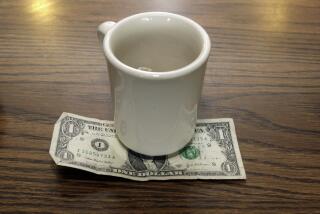Good or Bad Service, Many Diners Tip About the Same
- Share via
If the dining experience is less than satisfying, does the waiter get a smaller tip? Maybe, but not by much.
Poor restaurant service appears to be rewarded nearly as well as good service, according to a study of three eateries in Houston and Columbia, Mo.
“If people get so-so service, they’re likely to leave a standard tip and not reduce it. If they reduce it, it will be by very little,” said Michael Lynn, an associate professor of consumer behavior and marketing at Cornell University’s School of Hotel Administration.
Asked to rate their dining experience on a scale of 1 to 5, patrons of The Olive Garden and Bennigan’s restaurants in Houston who gave a 4.6 or higher rating left a tip averaging 16.6% of the bill. Those who rated the service 4.4 or lower left 14.2%.
The same pattern emerged in a survey at a Red Lobster in Columbia, Mo. Those who praised the restaurant left an average 12% tip; those who didn’t express praise tipped 10%.
Why would people stay the course on tipping when the service is poor?
“I’ve heard of cases where servers have publicly embarrassed people who left small or no tips at all, but that’s rare,” Lynn said.
Lynn’s study with Jeffrey Graves of the University of Houston will appear in an upcoming issue of Hospitality Research Journal.
Tipping is not an incentive for excellent service unless customers differentiate between good service and bad, he said.
His advice:
Never stiff a waiter, but vary the size of the tip based on the quality of service. The etiquette manuals, he said, suggest 10% for bad service, 15% for reasonable service and up to 20% for good service.
More to Read
Inside the business of entertainment
The Wide Shot brings you news, analysis and insights on everything from streaming wars to production — and what it all means for the future.
You may occasionally receive promotional content from the Los Angeles Times.









